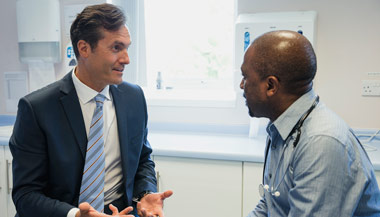Health Ask The Expert
Tips for Keeping a Healthy Prostate

Featured Expert:
Prostate problems can be uncomfortable and worrisome. But, says urologist Christian Pavlovich, M.D., who specializes in urologic cancers, you can take charge and reduce your risk with the following steps for a healthier prostate.
1. Consider a Mediterranean Diet
The Mediterranean diet may well be the best way to keep your prostate healthy overall, without the need for unproven supplements or vitamins, none of which have been shown to prevent prostate cancer.
The Mediterranean diet is rich in a variety of fresh fruits and vegetables, and also:
- Whole grains
- Legumes
- Healthy fats from sources such as olive oil, nuts, seeds and fatty fish
- Moderate amounts of seafood
- Low amounts of dairy and red meat
While you’re filling your plate with fresh fruits and vegetables, avoid charred meats. There is believed to be a link between PhIP, a chemical compound released when meat is charred, and an increased risk of cancer.
2. Skip vitamin E supplements
While no supplements or vitamins have been shown to decrease a man’s risk of developing prostate cancer, one vitamin taken has been shown to increase a man’s risk of prostate cancer: Vitamin E. A national trial showed that subjects who took 400 IU/day of vitamin E for about five years had a 17% increase in prostate cancer diagnoses. Supplementing with Vitamin E is definitely not recommended for prostate health.
3. Get some sun
Don’t ditch the sunscreen, but don’t hide from the sun either. Too little sun exposure can actually increase your risk of getting prostate cancer. We get a lot of valuable vitamin D from the sun, and this is a great way to reduce your risk of prostate cancer.
Vitamin D also helps keep us healthy in other ways. It’s good for heart health, and it keeps your kidneys and pancreas healthy.
4. Get screened
Prostate cancer screening recommendations are different depending on whether you’re in a high-risk or an average-risk group. If you are in a high-risk group, you should consider getting screened for prostate cancer starting at age 40. Men who are at normal risk are encouraged to consider screenings starting between ages 45 and 55.
Men with a higher risk of developing prostate cancer include:
- African-Americans
- Men with a first- or second-degree relative with a history of:
- Metastatic prostate cancer
- Metastatic male breast cancer
- Female breast cancer at age 45 or younger
- Endometrial cancer at age 50 or younger
- Colon cancer
- Pancreatic cancer.
- Men with two or more first- or second-degree relatives who were diagnosed with:
- Prostate cancer
- Colon cancer
- Breast cancer
- Endometrial cancer
- Men with a known familial cancer syndrome or a known genetic risk for cancer such as a BRCA2 gene mutation
- Men exposed to Agent Orange
Screening typically includes a digital rectal exam and a PSA test. This blood test, commonly used to screen for prostate cancer, measures how much prostate-specific antigen (PSA) is in your blood.
If your PSA test indicates an above-normal result, your doctor may recommend a prostate MRI and other tests, including another blood test called the prostate health index (PHI).
- PHI is related to PSA, but it provides a more complete picture of prostate cancer risk. The test was FDA-approved in 2012, and Johns Hopkins is one of a few American medical centers to perform the test regularly.
- A suspicious digital rectal exam will lead to a recommendation for a prostate biopsy. But for a patient with an elevated PSA and a normal digital rectal exam, the doctor will assess the risk of cancer in context with the PHI or other blood or urine tests, an MRI, and the patient’s baseline risk status before recommending a prostate biopsy.
There are pros and cons to prostate cancer screenings, and a decision to begin screening should be made with your primary care doctor or urologist.



